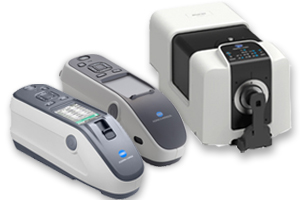The significance of quantifying color and gloss in one measurement
Within many spectrophotometers, there is an ability to present a “correlated” gloss reading. While this is sometimes helpful, the angle of measurement is not common nor available within most gloss meters and is not a true gloss measurement. There will also be some delay as the unit will need to take measurements in the SCI (specular component included) and SCE (specular component excluded) positions, not to mention an added calibration sequence. Due to the nature of its configuration and optics, this is not an option found in a colorimeter.
With new patented technology, Konica Minolta offers the ability to take a true gloss reading at 60-degrees (the universal gloss angle) while it measures the color of the sample. This technology will save the operator a great deal of time, as they will only need to calibrate one instrument one time. In most cases, once you turn an instrument off, recalibration is necessary. By having a true gloss meter incorporated within a spectrophotometer, you need only one calibration cycle. Also, and probably most important, the measurement will be done in the same spot for both color and gloss. Taking two measurements from the same spot is a crucial factor, especially if there is any variation in the sample’s surface. Lastly, you will eliminate the need to invest in and maintain two separate instruments, saving you money on the initial purchase and future maintenance and servicing costs.
Products such as the CM-25cG, CM-26dG, and CM-36dG all offer this complete solution of simultaneous color and gloss measurements. Using such high quality, close tolerance equipment will improve your speed to market and time to manufacture while reducing rework and waste due to variations in color and appearance.
Download our whitepaper “Simultaneous Measurement of Color & Gloss” to learn more about this topic.











